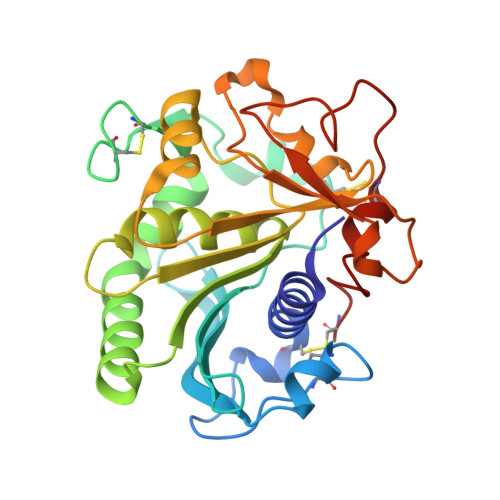Controlled lid-opening in Thermomyces lanuginosus lipase- An engineered switch for studying lipase function.
Skjold-Jrgensen, J., Vind, J., Moroz, O.V., Blagova, E., Bhatia, V.K., Svendsen, A., Wilson, K.S., Bjerrum, M.J.(2017) Biochim Biophys Acta 1865: 20-27
- PubMed: 27693248
- DOI: https://doi.org/10.1016/j.bbapap.2016.09.016
- Primary Citation of Related Structures:
5AP9 - PubMed Abstract:
Here, we present a lipase mutant containing a biochemical switch allowing a controlled opening and closing of the lid independent of the environment. The closed form of the TlL mutant shows low binding to hydrophobic surfaces compared to the binding observed after activating the controlled switch inducing lid-opening. We directly show that lipid binding of this mutant is connected to an open lid conformation demonstrating the impact of the exposed amino acid residues and their participation in binding at the water-lipid interface. The switch was created by introducing two cysteine residues into the protein backbone at sites 86 and 255. The crystal structure of the mutant shows the successful formation of a disulfide bond between C86 and C255 which causes strained closure of the lid-domain. Control of enzymatic activity and binding was demonstrated on substrate emulsions and natural lipid layers. The locked form displayed low enzymatic activity (~10%) compared to wild-type. Upon release of the lock, enzymatic activity was fully restored. Only 10% binding to natural lipid substrates was observed for the locked lipase compared to wild-type, but binding was restored upon adding reducing agent. QCM-D measurements revealed a seven-fold increase in binding rate for the unlocked lipase. The TlL_locked mutant shows structural changes across the protein important for understanding the mechanism of lid-opening and closing. Our experimental results reveal sites of interest for future mutagenesis studies aimed at altering the activation mechanism of TlL and create perspectives for generating tunable lipases that activate under controlled conditions.
Organizational Affiliation:
Department of Chemistry, University of Copenhagen, Universitetsparken 5, DK-2100 Copenhagen Ø, Denmark; Novozymes A/S, Brudelysvej 35, DK-2880 Bagværd, Denmark.


















